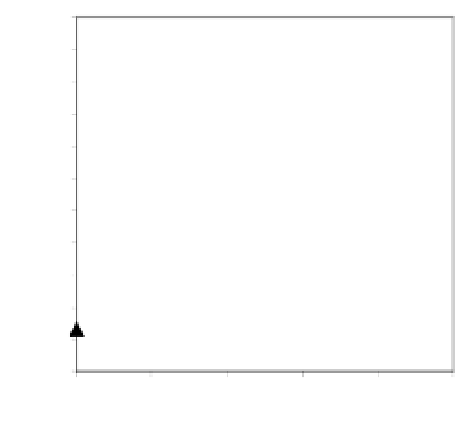Biomedical Engineering Reference
In-Depth Information
8.0
7.5
0 mg Cr/l
1 mg Cr/l
5 mg Cr/l
25 mg Cr/l
0 mg Cr/l
1 mg Cr/l
5 mg Cr/l
50 mg Cr/l
7.4
7.8
7.3
7.6
Chlorella Vulgaris
7.2
Chlorella Fusca
7.4
7.1
7.0
7.2
6.9
7.0
6.8
6.8
6.7
6.6
6.6
0
100
200
300
400
500
600
0
100
200
300
400
500
600
700
Ti m e ( h )
Ti m e ( h )
7.6
7.5
0 mg Cr/l
1 mg Cr/l
5 mg Cr/l
25 mg Cr/l
0 mg Cr/l
1 mg Cr/l
5 mg Cr/l
25 mg Cr/l
7.5
7.4
7.4
7.3
7.3
7.2
Scenedesmus Acutus
7.2
Scenedesmus Obliquus
7.1
7.1
7
7
6.9
6.9
6.8
6.8
6.7
6.7
6.6
6.6
6.5
6.5
0
100
200
300
400
500
0
100
200
300
400
50
Ti m e ( h )
Ti m e ( h )
Figure 6. Evolution of pH over time (T = 21-22 ºC; initial pH = 6.6-6.7; arrow indicates the moment of
Cr addition).
The logistic fittings to the experimental results are also displayed in Figure 5 and the
corresponding parameter values are presented in Table 3.
Hexavalent chromium
concentrations up to 5 mg l
-1
seem not to negatively affect the initial specific growth rate of
biomass
(μ) of
C. fusca
and the presence of 1 mg l
-1
even increases μ. However, the
maximum biomass concentration (
K
) continuously decreases as Cr(VI)
concentration
increases. According to Wong et al. [20],
C. fusca
is known for its tolerance to heavy metals,
which explains this behaviour. On the other hand,
C. vulgaris
(Figure 5) is less tolerant to
Cr(VI) than
C. fusca
. Although the addition of 1 mg l
-1
does not affect the normal
development of the population, growth is interrupted within a few hours for Cr(VI) = 5 mg l
-1
.
The effect of the presence of Cr(VI) on growth kinetics of
S. acutus
is similar to that observed
for
C. fusca
, even though a lower maximum biomass concentration (
K
) has been reached for
Cr(VI) = 5 mg l
-1
.
The presence of Cr(VI) up to 5 mg l
-1
practically does not affect the
biomass specific growth rate of
S. obliquus
, but the maximum biomass concentration (
K
)











































































